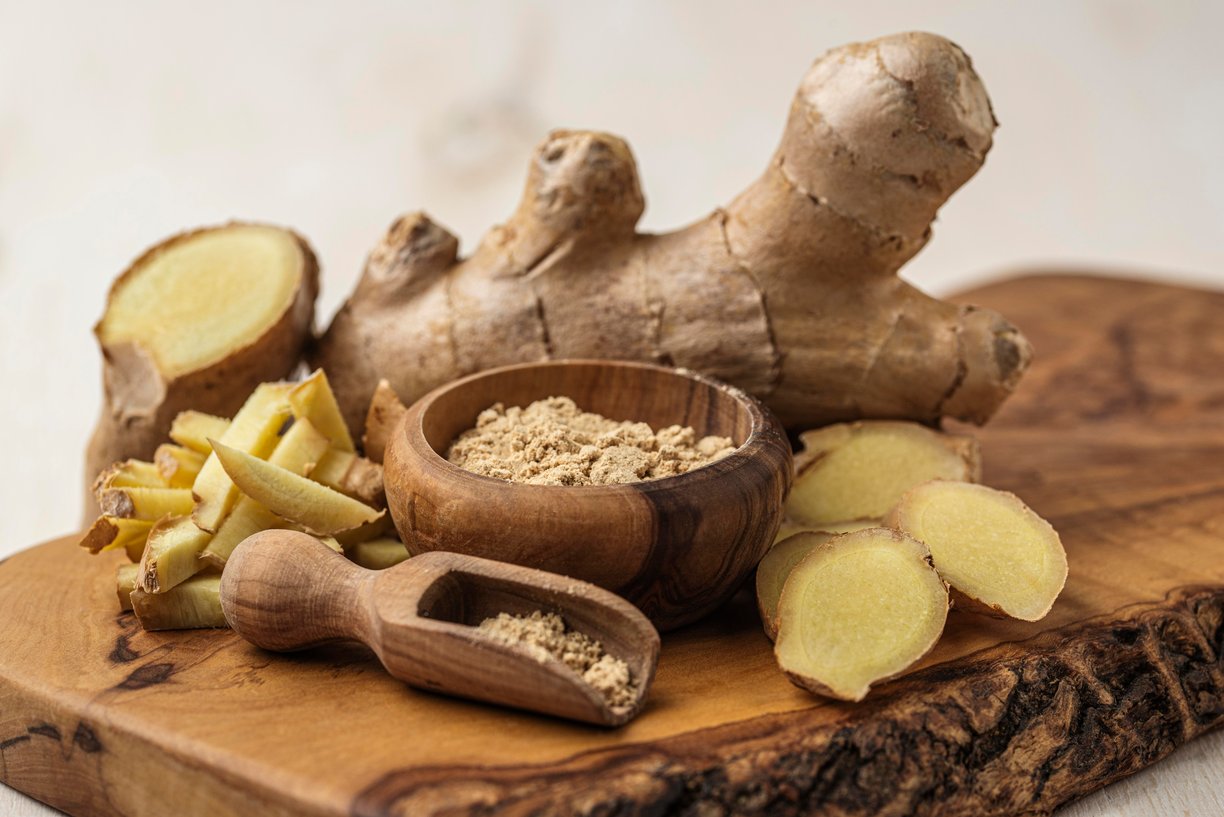Ginger
Ginger is not a root, actually it is a rhizome. A rhizome is an underground stem. Ginger can be grown from rhizomes, available at grocery stores. The mature ginger rhizomes can be harvested after 10-12 months. A ginger plant can grow as high as 4 feet. The ginger plant is an herb. Ginger is a part of the Zingiberaceae
HEALTHY & FUN FRUITY FACTS
Ginger is not a root, actually, it is a rhizome. A rhizome is an underground stem. Ginger can be grown from rhizomes, available at grocery stores.
The mature ginger rhizomes can be harvested after 10-12 months. A ginger plant can grow as high as 4 feet.
The ginger plant is an herb.
Ginger is a part of the Zingiberaceae family. Turmeric & Cardamom are included in this family.
Ginger is native to southeastern Asia. Ginger is popularly grown in warmer regions & the tropics. India ranks number one in World’s production, & also amongst the top 10 global exporters.
Cultivation of Ginger can be during an entire year but the best time to plant them is at the end of winter & early spring.
Ginger was a common trade product from the East to Europe by the 11th century CE.
Ginger was introduced to the West Indies & Mexico by the Spanish after their conquest of these two countries, & by 1547 ginger was being exported from Santiago to Spain.
Presently, natural ginger ales made with fresh ginger are available as a digestive tonic. Years back Jamaicans & early American settlers used to make beer from ginger.
The generic name of this spice is “Zingiber” which is derived from the Greek zingiberis. This word in turn comes from the Sanskrit name of the spice, singabera.
The English nomenclature i.e. “ginger”, comes from the mid-14th century, from Old English gingifer; also from Medieval Latin gingiber. It is also derived from Greek name zingiberis, & from Prakrit (Middle Indic) singabera.
Ginger rhizomes are often used to flavor breads, sauces, curry dishes, confections, pickles, ginger ale & ginger beer.
Chinese & Ayurvedic practitioners have relied on ginger for at least 3,000 years for its anti-inflammatory properties, & have used it as a “carrier” herb, one that enables other herbs to be more effective in the body.
Ginger is high in gingerol, a substance with powerful anti-inflammatory & antioxidant properties. In a recent study, taking 5 grams of ginger a day for 3 months lowered people’s LDL cholesterol by an average of 30 points.
Gingerol appears to have protective effects against cancer. However, more studies are needed. Gingerols keep oral bacteria from growing. These bacteria are the same ones that can cause periodontal disease, a serious gum infection.
Just 1–1.5 grams of ginger can help prevent various types of nausea, including chemotherapy-related nausea, nausea after surgery, & morning sickness.
According to studies in animals & humans, ginger may help improve weight-related measurements. These include body weight & the waist-hip ratio.
There are some studies showing ginger to be effective at reducing symptoms of osteoarthritis, especially osteoarthritis of the knee. Ginger is an anti-inflammatory, which means it reduces swelling. You might get relief from pain & swelling either by taking ginger by mouth or by using a ginger compress or patch on your skin.
Ginger has been shown to lower blood sugar levels & improve various heart disease risk factors in people with type 2 diabetes. One recent small study suggested that ginger may help your body use insulin better. Larger studies are needed to see if ginger could help improve blood sugar levels.
Ginger appears to speed up the emptying of the stomach, which can be beneficial for people with indigestion & related stomach discomfort. If you live with chronic indigestion, also called dyspepsia, ginger could bring some relief. Ginger before meals may make your system empty faster, leaving less time for food to sit & cause problems.
Ginger appears to be very effective against menstrual pain when taken at the beginning of the menstrual period. In studies, women who took 1,500 milligrams of ginger powder once a day for 3 days during their cycle felt less pain than women who didn’t.
There’s some evidence, in both humans & animals, that ginger can lead to significant reductions in LDL (bad) cholesterol, total cholesterol, & blood triglyceride levels. In a recent study, taking 5 grams of ginger a day for 3 months lowered people’s LDL cholesterol an average of 30 points.
Animal studies suggest that ginger can protect against age-related damage to the brain. It can also help improve brain function in middle-aged women.
Ginger may help fight harmful bacteria & viruses, which could reduce your risk for infections. They’re especially good at halting growth of bacteria like E.coli & shigella, & they may also keep viruses like RSV at bay.
Ginger won’t whisk away muscle pain on the spot, but it may tame soreness over time. In some studies, people with muscle aches from exercise who took ginger had less pain the next day than those who didn’t.
Some studies show that bioactive molecules in ginger may slow down the growth of some cancers like colorectal, gastric, ovarian, liver, skin, breast, & prostate cancer. But much more research is needed to see if this is true.
Ginger


